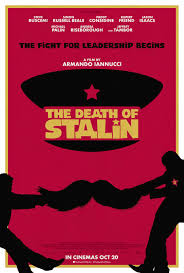
If you didn’t see The Death of Stalin when it opened in theaters this past weekend, and judging by the box office numbers, you didn’t, then you missed a biting satire with a script that performs dialogue gymnastics and a troupe of actors who brought their A-games to the screen. This is a thoughtful and funny film that might not be for everyone, but if you like satire and thoughtful humor, this is a film for you.
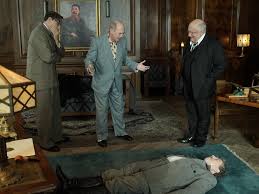
The film opens during the final days of Stalin’s reign as Secretary General of the Soviet Union. His death marks the end of the first Act, and launches the rest of the characters on the adventure of who will succeed him. It is more of a misadventure, really, as the chaos created by this team of rivals trying to one-up each other without being killed by each other creates dramatic irony and humor that you’re almost ashamed to laugh at. In fact, that is the risk that director Armando Iannucci took in making this film. Josef Stalin could lay claim to being the most brutal dictator of the 20th Century. He had as many as 20 million people killed, countless more sent to gulags, and the lucky ones were exiled. A generation of Russians, Georgians, Lithuanians, Ukrainians, etc. lived in abject fear that they and their family could be rounded up and shot for the most banal of missteps, and Iannucci took that fear and created comic gold from it.
It could be that since Stalin died more than 60 years ago, and the Cold War fires he helped to stoke have themselves been extinguished for a generation, that allows for this genocide to be looked at through the prism of comedy without feeling that its seriousness is being diminished. In fact, when it’s done effectively, comedy can be more biting in its critique, more effective at showing the folly of those involved, and more unforgiving in pointing out their fallacies, than even the heaviest of dramas. What comedy is able to do more effectively than serious drama is to point out the absurdity of any situation, and few 20th Century ideals were more absurd than Soviet-style communism.
The Death of Stalin reminds those if us of a certain age who remember the Soviet Union and the ideals that kept it moving, will appreciate this film on a level that younger audience members might not be able to relate to. There are several jokes about not being able to act on even the simplest of ideas without having a committee meeting. The plot that drives the film is the absurdity in the transition of power. Since Stalin ruled over the Soviet Union with an iron fist, there was no plan of succession, and the people left behind had to sort it out in a way in which they were not entirely capable, and the film shows that incompetence to hilarious effect. Finally, once the power is sorted, we’re told that, even though Khrushchev would lead the Soviet Union for a decade, his hold on power was tenuous at best, and he would ultimately lose it to someone younger, hungrier and more ruthless than he.
There are two moments in the film that stood out to me in showing just how absurd the whole situation was. Overall, Iannucci did an outstanding job in general of showing the fear and paranoia in which the average citizens lived. It’s easy to forget in the world we live in today that such a world existed where you couldn’t even speak ill of the nation’s leadership in your own home for fear of your own children turning you in, but we see it clearly displayed here. Even after Stalin is dead, there is an underlying fear that everyone has that they’re acting in ways in which he would not approve. Even in death, Stalin casts a shadow over every character in the film that they can’t get out from under. However, these two specific moments are perhaps the funniest moments in the film, and clearly show just how unprepared these men were for the grave responsibility that befell them.
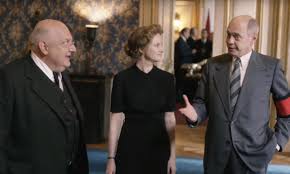
First, just after Stalin has died, his daughter Svetlana (Andrea Riseborough) arrives. The surviving members of the board, Khrushchev (Steve Buschemi), Molotov (Michael Palin), Malenkov (Jeffrey Tambor) and Beria (Simon Russell Beale) are already starting to try and position themselves for the top position. Within this group factions form and they individually try to curry favor with Svetlana in order to acquire any advantage that they can. During the climax of the scene when they finally decide to drive back to Moscow, a traffic jam occurs in the drive way as each tries to jocky himself into the position immediately behind Svetlana’s car. This is a signature moment in what makes comedy so great. Four people want the same thing and they want it badly. The absurdity in the moment is thinking that having a car closer to the front of the line will somehow give them an advantage, and yet they their hardest to accomplish something that any reasonable person knows means nothing until they’re on their way and Krushchev is left lamenting the fact that he’s in the back of the line.
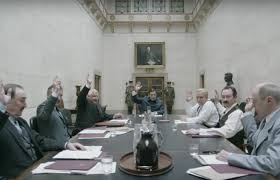
The other moment is when the whole board is together in a meeting room discussing the funeral and how other problems around Stalin’s death will be managed, and Molotov gives what might be one of the great verbal gymnastics performances of all time. Compound his going back and forth with the other members of the board not knowing whether to raise or lower their hands depending on however Molotov concludes his point and each sentence contradicting the one that came before it, and you have another side splittingly hilarious scene that has its humor derived from its absurdity. A point of order ought to be mentioned here in that I am a fan of Monty Python, and, while there are Pythonic elements in this film, one wouldn’t mistake it for Monty Python. However, in this scene, Palin hearkens back to those halcyon Python days with a performance that would have any Monty Python fan falling out of his or her chair in laughter.
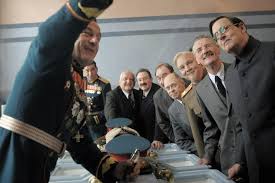
Similarly to the best of Monty Python, The Death of Stalin is a thinking person’s comedy. It’s a thoughtful film that will challenge the viewer in a way that modern films don’t often do. While I would stop just short of calling it a great film, I would still call it a very good film that I would recommend to anyone who is willing to put in the effort of seeing it. This isn’t a film that you can watch passively. You need to engage with this film. Fortunately the actors in it all give virtuoso performances, so that you can engage with the characters on an emotional level. Iannucci also made the interesting creative choice to be deliberate in his portrayal of the carnage of Stalin’s regime. There are some moments of graphic violence, but most of the atrocities happen off camera and out of sight, which is very symbolic of how they happened in reality. Not many people outside the Soviet Union knew what was happening at the time, and those inside the Soviet Union had to look the other way for their own self-preservation.
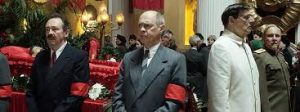
Overall, this is a film that is worthy of your time. It might be hard to find it in a theater, but you should endeavor to do so. These types of films need to be supported. With Black Panther having crossed the $1 billion mark, and more fair from Marvel and Star Wars and other ginormous franchises on the way, maybe we could take a break from seeing them again for a moment, and go see a film that isn’t flashy, isn’t a spectacle, but is no less cinematic and no less entertaining. You might surprise yourself and remember that there are still mid-level movies that provide theater-quality entertainment.